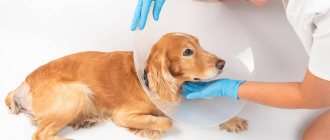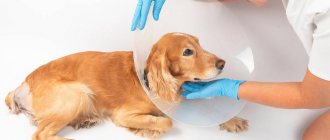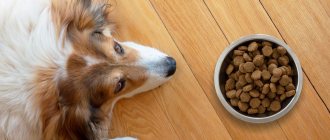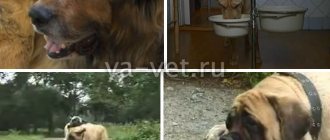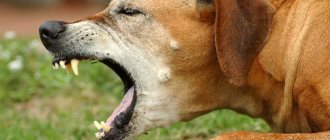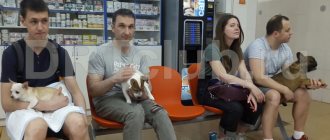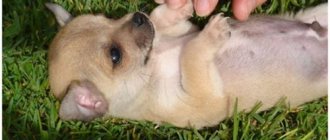Umbilical hernia in dogs is a fairly common occurrence. An animal may have a congenital pathology or an acquired one. Treatment of umbilical hernia in dogs is impossible; the only way out is reduction and suturing. The problem cannot be underestimated; a hernia is fraught with serious complications, including death. In this article we will talk about the causes of umbilical hernias in dogs of puppyhood and adults. Let's look at the types of such hernias and learn what to do if a problem arises.
What is an umbilical hernia?
This is a pathology in which the animal's insides - the bladder, uterus, omentum and intestines - fall out of the umbilical ring - an opening in the abdomen called the navel.
This condition is not always due to genetic predisposition. The abdominal muscles can weaken and the umbilical ring opens for many reasons. First of all, we will consider the causes of the disease in puppies, and then in adults.
Why do puppies develop umbilical hernia?
It is believed that the occurrence of the disease directly depends on the course of pregnancy and childbirth in the dog, as well as on the method of cutting the umbilical cord. It's not like that at all. Throughout pregnancy, puppies inside the dog's womb receive all the substances they need for life through the umbilical cord. When there is very little time left before birth, the umbilical ring - the place where the umbilical cord attaches to the tummy - begins to narrow. The baby’s entire body is preparing to receive on its own not only food, but also oxygen. You need to learn to breathe, so contractions of the peritoneum begin. But this is not a factor in the development of a hernia, it’s a matter of genetics.
At birth, the umbilical ring is still open, but within 24 hours it should shrink completely. If the ring has an irregular shape or the tone of the abdominal wall is weak, then an umbilical hernia may form in the dog in these very first days of life.
How to identify a hernia in a puppy?
If the owner of the woman in labor is attentive and caring, then he will regularly examine the babies. You do not need to be a qualified veterinarian to identify an umbilical hernia in a dog or newborn puppy. With pathology, a more convex area is noticeable on the tummy than the rest of the area. There will be a small, protruding ball on the skin.
Don't start panicking right away. Umbilical hernias often occur in puppies, and in almost all of them they disappear on their own over the next few days of development.
Pet care
After surgery, your dog needs time to recover. The owner will need:
- Treat seams. The specialist must determine the method taking into account the surgical material and post-procedure treatment.
- Give antibiotics. They are prescribed in cases where tissues with necrosis or areas of organs have been removed.
- Apply special ointments. They eliminate swelling, inflammation and disinfect and accelerate the healing of sutures.
- Provide your pet with complete rest for 1-2 days after surgery. Intense physical activity should be avoided for a long time. The specialist will indicate how long it is necessary to maintain this regime.
- Wear special postoperative bandages. They are prescribed according to indications. They will help provide protection against licking and maintain the results of the procedure.
- In the first two to three days, painkillers may be prescribed. It is important to monitor your dog's condition to determine whether they are necessary. Usually “Ketanov”, “Remadil”, “Travmatin” help.
For preventive purposes, you need to formulate a balanced diet for your pet with the required amount of vitamins. You can give your dog a light abdominal massage after eating. It should be done in a circular motion without pressing.
The pathology is usually hereditary, so such animals should not be allowed to reproduce. Surgery is often performed in conjunction with sterilization.
Hernia in dogs is diagnosed quite often and can occur at any age. The severity of the disease is influenced by many factors, so even with slight swelling you should visit a doctor. Only a veterinarian can determine the method of treating the pathology.
Causes of umbilical hernia in older dogs
If the problem arose in puppyhood, then the cause is a weak umbilical ring, and this is a congenital pathology. In adults, the problem may arise for other reasons.
- Peritoneal injuries, overload - do not force the dog to perform physical exercises by force, everything should be in moderation.
- Umbilical hernia in dogs after surgery is a common occurrence. The complication occurs due to an insufficient recovery period. Immediately after the sutures are removed, the animal cannot be loaded in the same way as before the operation, it must become toned, do not disregard the veterinarian’s recommendations for recovery, follow all instructions and rules.
- Frequent and multiple pregnancies of the dog. This problem often occurs when the dog walks on its own and the owner does not keep track of the mating. Another risk group is an inexperienced breeder who wants to make money on the fruiting of his pet, without caring about her condition. If you breed a breed, then take the dog the recommended number of times a year; after one pregnancy, you cannot immediately take it to the groom again. If you don’t want to breed animals, then it’s better to sterilize your pet, this is the key to its health and your peace of mind.
- Frequent constipation. This may be due not only to poor nutrition, but also to intestinal pathology. If you notice such a problem, the first thing you need to do is contact your veterinarian. If no diseases are found, then completely review your pet’s menu; if necessary, put it on a diet.
- The cause of a hernia can be another disease - ascites.
- Persistent bloating.
- High pressure inside the peritoneum.
If the owner himself can determine the penultimate factor by the frequent “gas contamination” of the room, then only a veterinarian can determine the latter. It is precisely because of frequent disturbances in the functioning of the body, invisible to the eye, that dogs must be taken to the veterinarian annually for examination. The animal cannot say where, what and how it hurts, and often does not even show its abnormal condition.
Symptoms of a tumor on the abdomen
Both congenital and acquired hernia are easily noticed when examining a puppy: there is a small swelling on the abdomen - from a few millimeters to two centimeters. In severe cases, its size can be equal to the volume of a chicken egg or even larger. This swelling is quite soft and is easily pushed into the peritoneum.
More careful palpation allows you to feel a hard hernial ring. But only a veterinarian with relevant experience can diagnose an umbilical hernia, since a tumor on a dog’s abdomen does not always indicate the presence of a problem - in some cases it is associated with other pathologies. Therefore, first of all, the owner of a dog who suspects that he has such a disease should contact a veterinarian.
In the case of a small hernia, the dog does not show signs of concern, since this formation does not cause it any discomfort, even when it is palpated. However, if palpation of the swelling causes pain in the animal, this means that the hernia is strangulated and the dog needs treatment.
A hernia in a puppy is dangerous in that its ring can cause pinching of tissues that have fallen into the hernial sac. This leads to poor circulation, leading to inhibition of intestinal or omentum functions. In this case, the symptoms of the disease worsen: the dog feels acute pain at the site of the pathology, becomes lethargic, loses appetite, and does not allow the hernia to be touched.
The external appearance of the swelling also changes: it swells, increases in size, and stands out in color from the surrounding tissues. In the absence of timely treatment, the consequences of an advanced disease can be quite severe, ranging from dysfunction of the peritoneal organs to death.
Types of umbilical hernias
Photos of an umbilical hernia in dogs can be seen in this material. This is a very common phenomenon, and some animals can live with this feature all their lives, while eating well, exercising and not showing pain, since there may not be any pain at all. This may be due to the growth of the omentum to the hernia; it does not fall out, but does not fall into place, it protrudes a little, which may be completely unnoticeable. In this state of affairs, the hernia can be left untouched; the dog will live without noticing the pathology throughout his entire happy canine life. Another thing is when an umbilical hernia appears in a dog with prolapse of the omentum, in this situation it is necessary to correct the pathology, suturing, narrowing, the umbilical ring. But about the operation later, let's look at the types of hernias in dogs of all ages.
If a bump appears on the tummy of a newborn, this is not a reason to make a diagnosis. Hernias are of the following types:
- A true hernia is a type of pathology in which the umbilical ring opens and some part of the organ passes through it. The most common organ that protrudes is the intestine.
- A false hernia is a type in which the navel ring opens, but organs do not pass through it, remaining in the correct position in their places. The skin pouch becomes soft due to filling with fatty tissue. With this type of hernia, the hernia is very mobile.
- A moving hernia is a type of pathology in which you can easily push the prolapsed organ back inside by slightly pressing the sac. The gate - the umbilical ring - does not prevent the reentry of the organ.
- A hard or immovable hernia is the most dangerous type of pathology, in which the umbilical ring, after prolapse of the organ, sharply narrows and remains in that position. In this condition, an internal organ becomes pinched.
Hernia in the spine
As a result of stress on the spine, intervertebral discs become displaced. In this situation, it is important how much the spinal cord is affected. You can recognize the presence of a spinal hernia by the dog’s behavior. Slow movements, tension in the back muscles, and difficulty bending the head indicate the presence of pathology.
This type of hernia is the most dangerous, as it can lead to paralysis. If you suspect a vertebral hernia, you should contact a veterinary clinic as soon as possible. The doctor will conduct a full examination and take an x-ray of the spine. Based on the data obtained, the veterinarian prescribes therapeutic therapy. For mild cases of intervertebral disc displacement, anti-inflammatory drugs are prescribed. With an advanced form of hernia, urgent surgical intervention is necessary.
Hernia dimensions
If a small bump appears in the navel area of even an adult animal, you should urgently show your pet to a veterinarian. It is not a fact that the hernia will remain this size; it can grow to the size of a lemon or a chicken egg, depending on the size of the dog and the tone of the umbilical ring. This may not happen at all; the dog will live its entire life without knowing about the pathology. Or it can happen differently - the hernia will “grow” sharply even with a small load, pinching will occur and the pet will simply die within a few hours.
A lump in the navel area does not always indicate a hernia. It could be a harmless wen or a dangerous cancerous tumor. In any case, the pet should be shown to a doctor, even if it does not show signs of an uncomfortable condition.
Why are hernias on the navel dangerous?
Veterinarians recommend that the hernia be repaired without fail, and the sooner this happens, the less risk there is to the life and health of the animal. Even if a puppy has a formation, you should not expect it to resolve on its own. The reason for this is obvious - the umbilical ring can close at any time, and the contents of the skin sac will be pinched. Why is this dangerous?
- When the intestines are pinched, vomiting begins first and the dog suffers from constipation.
- If the pinching has absorbed part of the bladder, stagnation of urine will begin, which will lead to kidney failure.
- When pinched, a dog experiences severe pain.
- Blood circulation is impaired.
- Blood does not flow into the pinched part, a lack of oxygen begins, and the tissues pinched by the ring begin to die.
- Dead tissue disintegrates, which causes intoxication of the body.
- If no measures are taken, the dog will fall into a short coma and then die.
If the necrotic process has begun, then the animal owner will have a matter of minutes to deliver the pet to the clinic, and there he will immediately go to surgery, where the umbilical hernia will be removed.
Dogs with a false hernia do not require surgery; it is not dangerous to health unless the dog himself begins to scratch it and injure it.
Looking for the navel
Some owners remember seeing their dogs' belly buttons when they were first born. But many have not seen their puppy born, and after the first few weeks it becomes difficult to see where the belly button is because it is so small and covered in hair. Even the shortest hair can hide your belly button if you don't know what you're looking for.
In very short-haired breeds, you may notice a swirling pattern around the belly button, which will help you find it. But in other breeds it can be difficult to see, so here's a quick step-by-step guide to finding the belly button:
- use your hands to find the navel by touch;
- find their chest and move to its center;
- follow the chest to the last rib;
- move just below their chest and make sure you are still near the middle;
- often between the nipples, feel a small line in the center of their lower part;
- it should be their navel;
- You may not find it right away, but keep going - it's out there somewhere!
I don't know about your pets, but mine don't really want to stay still long enough for me to find their belly button. So, a great tip to help you find one is to include one of their favorite things to do in your search: belly rubs! Rubbing your belly is a great chance to feel your underbelly for scratches, bumps and other health problems, as well as find your belly button.
© shutterstock
You can also catch them in a calm, peaceful moment, such as watching TV together. You may need to be careful not to shock them by suddenly grabbing the bottom and they may not be in the best position for you to see what you are doing. My advice is to be patient and start with light stroking and gradually move to a position where you can gently rub your belly.
Diagnostics
If the condition is not acute, the dog does not show its condition in any way, or the symptoms are weak, but the owner has already brought the pet to the clinic, he will be immediately sent for an ultrasound. After this, you will need to donate blood for analysis to make a more accurate diagnosis.
In case of an acute condition, there is no time to waste. Without prior diagnosis, the dog will be immediately referred to a surgeon.
Surgery to remove an umbilical hernia in a dog
There's nothing wrong with that. If the organs have not come out through the ring, then the doctor will simply straighten the abdomen carefully and suture the hernial orifice.
If there are organs in the bag, then first you will have to open this bag to check the condition of these organs. If there are no injuries or other problems, then they are also reduced, and the surgeon sutures the gate.
If there was pinching, then there is a high probability of tissue death. In this case, they are removed and cleaned, which is dangerous for the life of the animal. Only then will the doctor realign the organs and suture the gate.
There will be no relapses after the operation. Once recovered, the dog will begin to live its normal life.
Treatment method and prognosis
The main way to treat a hernia is surgery. In case of prolapse of organs and their infringement, this is generally the only way to save life. The displaced organs are returned to their place; if the tissue begins to die, they are excised, and the umbilical ring is sutured.
To improve healing and prevent the development of infection, the animal is prescribed drug therapy, including painkillers, anti-inflammatory drugs, and antibiotics.
With timely intervention, the prognosis is positive. There is a risk of re-formation of hernias, so animal care and preventive measures are of great importance.
Actions at home
If an umbilical hernia appears in a dog, every owner should know what can and cannot be done.
Under no circumstances should you try to correct the pathology yourself. Your actions can lead to complications - pinching or even rupture of organs. Do not do anything other than contact your doctor.
After surgery, the dog will need a warm, dry place in the house. The wound will need to be treated with disinfectants. The veterinarian will prescribe a diet that you must adhere to! Buy your animal a bandage so that when he stands up, his stitches do not come apart.
Hernia in the perineal area
A perineal hernia occurs in dogs due to weakening of the pelvic muscles. Outwardly it looks like a rounded protrusion under the tail on the side of the anus. The cause of perineal pathology can be straining of the abdominal muscles due to defecation, trauma, or congenital pathologies of the genital organs. Most often, this species is found in dogs, mainly small short-tailed breeds.
Symptoms manifest themselves as a deterioration in the dog’s condition, with lethargy, apathy, frequent constipation and urination. At the initial stage, a perineal hernia is soft and painless, does not cause discomfort and is treated with medication. Due to the progression of the disease, the swelling in the perineal area increases in size and becomes painful.
To eliminate the pathology at this stage, surgical actions are performed. After surgery, patients are prescribed a course of antibiotics, special food and diet. During the first month after surgery, loads and sudden movements are contraindicated. The pet needs peace and careful care.
